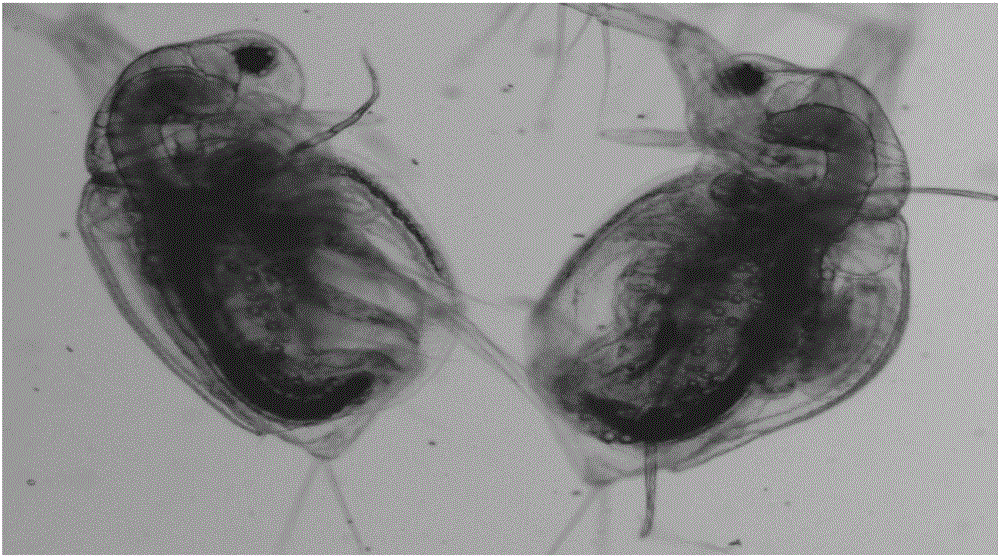Method for improving daphnia growth and propagation capacity and enhancing bait nutrition performance
A nutritional and water flea technology, applied in animal feed, animal feed, application, etc., can solve the impact of aquatic animal survival rate, growth rate and disease resistance, restrict the production of water flea and product quality, and it is difficult to effectively and fully Provide and other issues to achieve the effect of reducing drying links and energy consumption, avoiding environmental pollution pressure, and reducing production costs
- Summary
- Abstract
- Description
- Claims
- Application Information
AI Technical Summary
Problems solved by technology
Method used
Image
Examples
Embodiment 1
[0025] Take two 50-liter incubators, add 40 liters of 25‰ seawater to them, and inoculate them with isopycnic daphnia (1 / ml), and cultivate them in a natural light greenhouse with sufficient ventilation for 12 days. During this period, add 15.0g fresh Nannochloropsis mud every day in one of them; Fully wall-breaking treatment) mixed product, wherein the mixed dry weight ratio of chlorella and haematococcus is 3:2 (that is, haematococcus accounts for 40% of the total microalgae bait).
[0026] The result shows: the growth and reproduction of the two feeding groups are good (see figure 1 ). During the whole culture period, in the control group fed with Nannochloropsis alone, the density of Daphnia reached a maximum of 32 / ml; while the density of Daphnia in the group fed with Nannochloropsis and Haematococcus broken algal residues was more, The highest reaches 37 / ml, and the individual density of Daphnia is increased by about 15%. At the same time, the bodies of Daphnia gnats ...
Embodiment 2
[0028] Take two 50-liter incubators, add 40 liters of 25‰ seawater to it, and inoculate isopycnic daphnia (1 / ml), and cultivate them in a natural light greenhouse with sufficient ventilation for 8 days. Wherein, 15.0g fresh Nannochloropsis mud is added every day in an incubator; Similarly, a mixed product of equal weight Nannochloropsis fresh algae mud and 1.5% Haematococcus fresh algae mud is added to another incubator , wherein the mixed dry weight ratio of chlorella and haematococcus mud is 4:1 (that is, haematococcus accounts for 20% of the total microalgae bait).
[0029] The results showed that: the dana moa in the two feeding groups obtained the phenomenon similar to that in the embodiment, and the dana belly grew and reproduced well. The control group fed Nannochloropsis alone, and the group fed Nannochloropsis and Haematococcus algae mud reached 10 / ml and 11 / ml respectively, and the densities of the two treatment groups. No obvious difference was shown. However, wit...
Embodiment 3
[0031] Take two 50-liter incubators, add 40 liters of 25‰ seawater to them, and inoculate Daphnia nuda at a density of 1 / ml, and cultivate them in a natural light greenhouse with sufficient ventilation for 10 days. During this period, 15.0g fresh Nannochloropsis mud was added every day in one of the incubators; Mixed product of slag, wherein the mixed dry weight ratio of chlorella and haematococcus algal residue is 1:1 (that is, haematococcus accounts for 50% of the total microalgae bait).
[0032] The results confirmed that the growth and reproduction of Daphnia in the two feeding groups were good. And during the whole culture period, compared with the control group fed with Nannochloropsis and Haematococcus algal residues, the density of Hydraphyllia was also more, and the trend of increase of Hydraphysis, insect The body size and color are basically similar to the results of Example 1.
[0033] The above results also further indicated that whether the astaxanthin-rich Hae...
PUM
 Login to View More
Login to View More Abstract
Description
Claims
Application Information
 Login to View More
Login to View More - R&D
- Intellectual Property
- Life Sciences
- Materials
- Tech Scout
- Unparalleled Data Quality
- Higher Quality Content
- 60% Fewer Hallucinations
Browse by: Latest US Patents, China's latest patents, Technical Efficacy Thesaurus, Application Domain, Technology Topic, Popular Technical Reports.
© 2025 PatSnap. All rights reserved.Legal|Privacy policy|Modern Slavery Act Transparency Statement|Sitemap|About US| Contact US: help@patsnap.com


